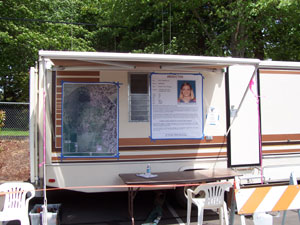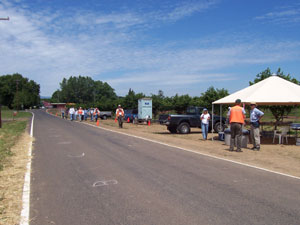| Member hours: 174.25 (plus travel time); Member mileage: 607 Participants: Clunes, Lyall, Sears, Wood, S. Linn, Crawford, J. Linn, Dagata, Adolf, Freund, Greenwood. | |
| At 2030, 24 May 2004, an ALL SAR page was sent out by Benton County Sheriff’s Office requesting assistance searching for a missing 19-year-old woman, Brooke Wilberger. She was last seen around 1030 that morning in the parking lot of an apartment complex on SW 26th, near Western Blvd, Corvallis. After friends and family searched for several hours, she was reported missing around 1600. Evidence found at the point last seen included Brooke’s shoes, and some personal items. Trackers and dogs were used before the rest of Benton County SAR assets were contacted. | |
|
The search began as soon as possible after the 2030 page, with staging in the Reser Stadium parking lot at 26th and Western. The search wound down around 0100, to begin again at 0900.
Staging on 25 May was at Avery Park, near the Parks and Recreation office at 0900 for SAR certified volunteers, with community volunteers expected at 1000. Additional community volunteers were scheduled at 1200 and 1400. The search area included Avery Park, Martin Luther King Park, as well as private property on the east side of the Willamette River. The strategy was to search areas of easy egress from the point last seen. Ms. Wilberger is a member of the Church of Jesus Christ of Latter Day Saints, and the church has played a critical role in organizing community volunteers by signing people up for different search shifts, as well as providing food and other supplies to the searchers. |
 Communications van with map of search area and poster of Brooke |
 Inside the comm van ARES members kept track of teams |
On 26 May, the command post was relocated to SW Brooklane Avenue, just off of Philomath Blvd, on OSU land. Again, SAR volunteers were to stage at 0900, with community volunteers staging at 1000, 1200 and 1400. The rivers were searched by Sheriff’s Office watercraft until low water levels stopped them. Canoes were used to search additional areas. The search area included part of OSU and private property. The search was halted in the late afternoon, with the last teams returning from the field at 1900. Trackers and dogs are being brought in periodically before the search recommences in the morning.
On 27 May, the command post was relocated to a development under construction about 2 miles down SW Brooklane from Philomath Blvd. Canoes continued to search waterways, as searchers combed wetlands and overgrown areas of private property. Property owners were accommodating and provided useful assistance. |
| On 28 May, the command post relocated yet again, to the parking lot of First Congregational United Church of Christ, at 4515 SW West Hills Road. SAR volunteers staged at 0900. With the Emergency Management SAR Coordinator Mike Morrow leaving until June 2, Dan Kearl, Mary's Peak SAR took over base ops, with support from Emergency Services Manager Peggy Peirson and Corporal Rich Riffle, as well as numerous other SAR volunteers. Community volunteers with previous experience during the search staged at 1000 and received training to be team leaders. Other community volunteers staged at 1100. A large area west and north of the church was searched. The area continued to be search on 29 May, with community volunteers filling team leader positions, while SAR volunteers managed several teams at a time. The search expanded to include 5 counties, with volunteers pairing up to drive roads. |
 Command Post on West Hills Rd |
 Team preparing to depart for the field |
May 30 and 31 had the command post at north end of Willamette Park, at Crystal Lake boat landing, off of Crystal Lake Drive. On the 30th, the plan was for 20 or so horses to search Bald Hill Park, off of NW 53rd Blvd. This group was lead by Benton County Sheriff's Posse and included community volunteers. The search technique changed from a shoulder-to-shoulder grid search to a "smart" search strategy, with a line of searchers arm lengths apart. This strategy allowed for a quicker search while continuing to have a high POD (possibility of detection).
On June 1 the command center returned to Avery Park, but at the other entrance, off of Avery Drive. Some teams returned to Willamette Park to finish of areas, while other teams searched private property around Avery Park. Water searches continued. |
|
The command center returned to the First Congretional Church on West Hills Road, on June 2. With Mike Morrow returning, a transition was made for him to take of Incident Commander from Peggy Peirson. Teams finished off areas around Avery Park, and some strike teams were sent to especially difficult areas. The search was fortunate enough to have a team of wildland firefighters from a Salem company volunteering every day throughout the search. Although they were sent to search the most difficult terrain, they commented that it was too easy! The main target area of the search was west of the church, on private property.
June 3rd saw a change of strategy with 2 command centers being established. One was at the Church of Jesus Christ of Latter Day Saints on Harrison Blvd. This one had the CMRU truck as the command center providing communications for teams searching the Frager area behind the Stake Center. Two CMRU members staffed this command center. The second, larger, command post was located on private property off of Hwy 99W, south of the Corvallis Airport. A school bus and driver were donated to assist with transportation on several days. Due to the Command Post location on private land on June 3rd, traffic was kept to a minimum and the bus helped tremendously with that. The bus picked up community volunteers from the Stake Center at 10, returned searchers at 1300, departing again with fresh searchers. After unloading the fresh searchers, the bus went to work busing children, returning to the Stake Center to pick up fresh volunteers at 1630. The bus brought tired searchers back to town before returning to the Command Post to wait for searchers to finish the day around 1900. The bus repeated this routine on June 4th and 5th. One bus driver was overheard commenting on how differently the bus handled with 50 adults onboard compared to 50 50-pounders! |
 Dean and Victoria staff the sign in/out tent
 Mike and Howard take advantage of the yurt during a lull in team deployments and planning. |
 Team returns to base along Kiger Island Road. |
 Command Post, Kiger Island Road. Letters in road were used to help form teams. Each team is given a letter for radio identification purposes. Each letter is only used on one deployment. |
|
On June 4th, the Command Post was set up on the shoulder of Kiger Island Road. Again, the bus was useful due to a severe lack of space! More private land was covered, as well as additional water areas. Who knew there were so many bodies of water in the Benton County area! Air support was also involved, with small fixed wing aircraft seen almost daily.
The final day of the official search was June 5th, which saw the Command Post set up at the Stake Center. Strike teams were sent out to several areas targeted by the Corvallis Police Department. The primary search area was the Frager property located behind the Stake Center. Additional water searches were conducted including drift boats, canoes, kayaks and a jet boat. In addition, the crew teams participating in the Corvallis-Portland Regatta volunteered to keep their eyes open for unusual sightings along their journey, covering territory that had not previously been searched.With the last teams returning to base around 1700, the official search was suspended. |
 The doors of the comm van were used for area maps and team designations (right). (Command Post at the Stake Center) |
 Anne (left), Jack, Aaron and Todd discuss plans for the search at West Hills Command Post. |
Search Overview The search for Brooke Wilberger began the evening of May 24th and was suspended on the evening of June 5th. The search covered over 4,000 acres, involved ________ community volunteer hours as well as _______ SAR certified volunteer hours. SAR volunteers started their days around 0800, to move and set up equipment for each Command Post, their days often ended sometime after 2000. The Corvallis Police Department was the lead organization in the search, conducting briefings every evening to target search areas. All Benton County Search and Rescue groups were involved: Mary's Peak Search and Rescue, Benton County Sheriff's Posse, Amateur Radio Emergency Services (ARES), Benton Emergency Rescue Team (BERTS - a youth mountain bike SAR group), as well as Northwest Search Dogs. The community provided air and water support, as well as horses and dogs. On the final days of the search, therapy dogs visited the Command Post to provide comfort and support to volunteers. |
|
Several hundred community volunteers participated every day, with over 700 estimated on one day. Consequently, SAR trained volunteers were very important in providing training, guidance and filling leadership positions on teams. Fortunately, Benton County had a recent group of SAR certified graduates, some members of existing units, others not, who provided invaluable leadership during this search. Volunteers came from surrounding counties and many dedicated over a week of their time to searching. Family members participated in the search on several days. They also visited the Command Post several times to voice their appreciation of the efforts being made.
As the search progressed, and more community volunteers returned, a multiple layer leadership system was developed. Team leaders led groups of 10-15 which combined first-timers with returning searchers. Groups of 2-4 teams were supported by Area Coordinators who provided support in the form of additional experience and expertise. Initially, Area coordinators were initially SAR trained volunteers. When there were large numbers of teams deployed, Super Area Coordinators were used, providing support to 2-3 Area Coordinators. As Area Coordinators became more familiar with the role, they were shadowed by community volunteers who had experience as Team Leaders, eventually becoming Area Coordinators. The training of community volunteers was part of a plan to facilitate continued searching after the official search was suspended. One of the pilots who volunteered their plane and flew over search areas, provided stacks of photographs. The developing was donated by a locally owned camera shop. It was interesting reviewing the photos and trying to figure out where some of them were taken! CMRU members participated on every day of the search. |
|